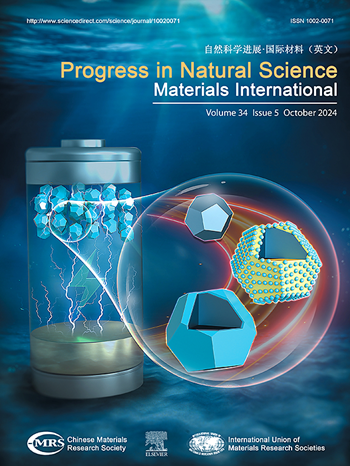Effect of Re on Dendrite evolution and segregation of nickel-based superalloys studied by phase field method
IF 7.1
2区 材料科学
Q2 MATERIALS SCIENCE, MULTIDISCIPLINARY
Progress in Natural Science: Materials International
Pub Date : 2025-08-01
DOI:10.1016/j.pnsc.2025.05.007
引用次数: 0
Abstract
Nickel-based single-crystal superalloys exhibit outstanding mechanical properties at high temperatures, and the addition of rhenium (Re) can significantly improve the alloy's temperature limit. To explore how the Re affects the dendrite morphology transition and micro-segregation in these alloys, we conducted directional solidification simulations of Ni-9 wt.%Al-x wt.%Re alloys (x = 3, 4, 5, 6). These simulations utilized a phase field model incorporating a fundamental thermodynamics database. By employing PANDAT thermodynamic software, the functional relationships between phase equilibrium composition, element concentrations, and temperature have been established and then integrated into the phase field model for accurate simulations. The simulation results show that the microstructure undergoes a planer-cell-dendrite morphology transition in the initial stage of directional solidification and ultimately maintains the dendrite morphology in the later stage. The Re content influences the speed of morphology transition; as the Re content increases, the solidification parameters, such as dimensionless undercooling (U) and dimensionless supersaturation (Ω), decrease, resulting in a delayed time that reaches the critical point of the morphology transition. During directional solidification, the distribution coefficients of Al and Re fluctuate initially but quickly stabilize, and the stabilized distribution coefficients of both Al and Re decrease with Re content. In addition, Al exhibits distinct enrichment in inter-dendrite regions and Re in dendrite cores. As Re content increases, the segregation degree of Al and Re is respectively intensified and reduced, which is the result of the combined effect of solute distribution coefficient and liquidus-solidus temperature range.
用相场法研究了稀土对镍基高温合金枝晶演化和偏析的影响
镍基单晶高温合金在高温下表现出优异的力学性能,铼(Re)的加入可以显著提高合金的温度极限。为了探究Re对这些合金中枝晶形态转变和微观偏析的影响,我们对Ni-9 wt.%Al-x wt.%Re合金(x = 3,4,5,6)进行了定向凝固模拟。这些模拟利用相场模型结合基本热力学数据库。利用PANDAT热力学软件,建立了相平衡组成、元素浓度和温度之间的函数关系,并将其集成到相场模型中进行精确模拟。模拟结果表明,定向凝固初期组织经历了平面-胞-枝晶形态转变,后期组织最终保持枝晶形态。稀土含量影响形貌转变的速度;随着稀土含量的增加,凝固参数(如无量纲过冷度(U)和无量纲过饱和度(Ω))降低,导致到达形貌转变临界点的时间延迟。在定向凝固过程中,Al和Re的分布系数在初始波动后迅速趋于稳定,随着Re含量的增加,Al和Re的稳定分布系数均呈下降趋势。Al在枝晶间区富集,Re在枝晶核区富集。随着Re含量的增加,Al和Re的偏析程度分别加剧和减弱,这是溶质分布系数和液固温度范围共同作用的结果。
本文章由计算机程序翻译,如有差异,请以英文原文为准。
求助全文
约1分钟内获得全文
求助全文
来源期刊
CiteScore
8.60
自引率
2.10%
发文量
2812
审稿时长
49 days
期刊介绍:
Progress in Natural Science: Materials International provides scientists and engineers throughout the world with a central vehicle for the exchange and dissemination of basic theoretical studies and applied research of advanced materials. The emphasis is placed on original research, both analytical and experimental, which is of permanent interest to engineers and scientists, covering all aspects of new materials and technologies, such as, energy and environmental materials; advanced structural materials; advanced transportation materials, functional and electronic materials; nano-scale and amorphous materials; health and biological materials; materials modeling and simulation; materials characterization; and so on. The latest research achievements and innovative papers in basic theoretical studies and applied research of material science will be carefully selected and promptly reported. Thus, the aim of this Journal is to serve the global materials science and technology community with the latest research findings.
As a service to readers, an international bibliography of recent publications in advanced materials is published bimonthly.

 求助内容:
求助内容: 应助结果提醒方式:
应助结果提醒方式:


